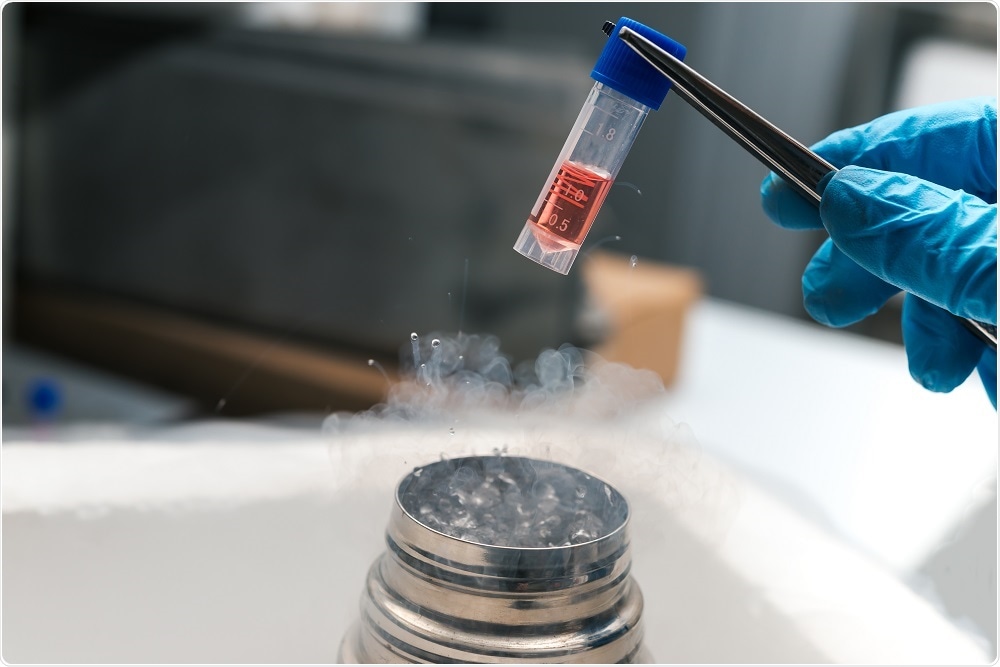An interview with Dr. Ann Smith, conducted by Kate Anderton, BSc
What is cord blood? How is it isolated?
Cord blood is the blood left in the umbilical cord following the birth of a baby. The collection process for cord blood is always secondary to the wellbeing of the mother and baby. It is carefully extracted when the baby has been separated from the cord and the placenta has been safely delivered.

Credit: Elena Pavlovich/Shutterstock.com
The cord blood unit is collected by a trained healthcare professional into a special bag with an anticoagulant to prevent clotting. This is then taken to the laboratory where the cord blood is tested and processed under sterile conditions to yield the stem cell rich fraction. This fraction is then frozen and stored at ultra-low temperatures under very stringent conditions to optimize the viability of the critical stem cells.
Why might cord blood be useful in the treatment of autism?
Cord blood transplantation for cancers of the blood and bone marrow and other blood conditions has been established for many years. Nowadays, the boundaries are expanding and research has shown that cord blood has the potential to be used in regenerative medicine.
An exciting new direction recently emerged from Duke University Medical Centre, where researchers are conducting a clinical trial to evaluate the effectiveness of cord blood for improving outcomes of children with autism spectrum disorder. This phase II trial follows an initial study which a) confirmed the safety of the treatment and b) began to establish measurable outcomes in children following treatment. Improvements in the childrens’ behavior were noted based on parent reports in addition to clinical assessment.
Previous research has shown that cord blood cells can help reduce inflammation and also induce cells already located in the brain to repair damaged areas. It is hoped that these observations may aid the development of treatments.
However, the clinical team running the initial trial recommend caution in interpreting the results as it is not possible to determine for sure whether the behavioral changes were due to the treatment or the natural course of development in young children. The phase II trial now underway will be looking more closely at measurable changes.
How is Smart Cells working to provide stem cells for children with autism?
Smart Cells has previously successfully released cord blood samples to the Duke University Medical Centre for a regenerative medicine purposes, mainly to treat children with ischemic brain damage resulting in cerebral palsy.
Our excellent quality assurance procedures are the reason we were able to meet the stringent requirements of the Duke medical team. We hope to maintain this relationship and continue to collaborate with investigators at the university to aid research into the possibility of using cord blood in the treatment of autism.
What impact does the storage of cord blood have on a patient’s quality of life?
Storage of cord blood may or may not have an impact on a patient’s quality of life. There are many factors that govern whether a patient is suitable for treatment using cord blood but if such treatment is appropriate, then the benefit may be considerable in either mainstream transplantation for blood cancers and other disorders or in the field of regenerative medicine.
Can cord blood be used to alleviate the symptoms of any other diseases?
Yes, cord blood transplantation is very well established in the treatment of blood and bone marrow cancers and other blood diseases such as sickle cell disease and thalassaemia. More recently, encouraging results have been observed in various more innovative applications, for example in the treatment of autoimmune, neurological, cardiac, skin and orthopedic problems.
What does the future hold for Smart Cells?
We are at an exciting time for the future of stem cell therapeutics with real potential being realised for innovative uses of cord blood derived stem cells in regenerative medicine.
Our aim is to maintain stringent standards to ensure that the products we produce meet the criteria demanded by world class treatment centers and that we remain responsive to innovations and developments in the future. Smart Cells will continue to provide a comprehensive and high quality service to parents wishing to bank their child’s cord blood.
Where can readers find more information?
The Smart Cells Website
About Dr. Ann Smith

Ann is the Scientific Director of Smart Cells International. She came to the company with 29 years of experience in the field of stem cell processing, storage, therapeutic transplantation and associated regulations and standards.
Ann is a trained stem cell processing facility inspector. In her most recent healthcare post as a Consultant Clinical Scientist, she was Head and Director of the busiest NHS transplant laboratory in the UK, serving paediatric and adult Haematology/Oncology patients.
Previously, she was involved in the early days of bone marrow transplantation, participated in the transition to peripheral blood stem cell transplantation for haematological malignancies and the introduction of ex vivo stem cell manipulations.
Her career has included senior roles in academia and research and she continues to maintain strong collaborative links with the University of the West of England, where she holds the position of Visiting Professor.